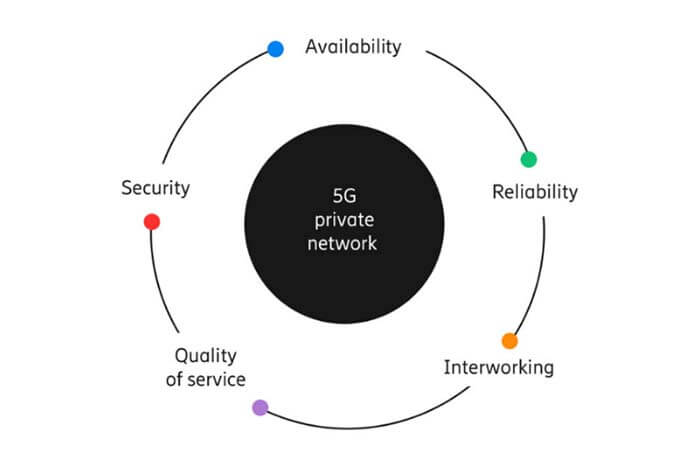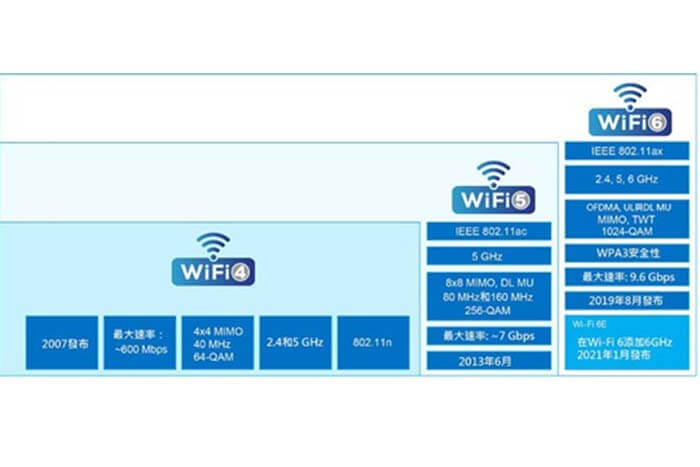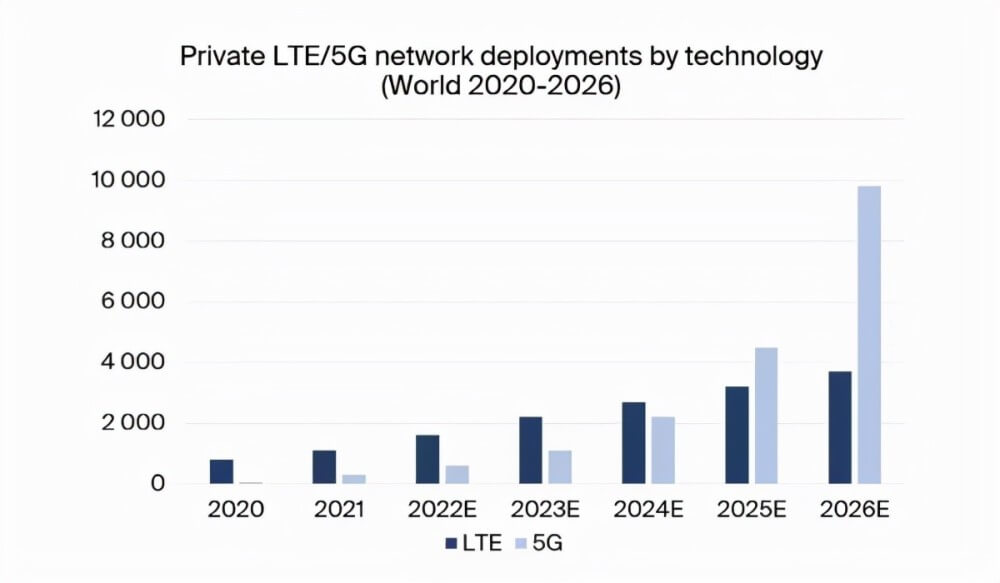After the read, you will know, what is a private 5G network and how a 5G private network works.
What is a private 5G network?

A private 5G network is a wireless network that uses the 5G mobile networking standard and is owned and operated by a single organization, rather than a commercial telecommunications provider. Private 5G networks are often set up for use by a specific business or organization and can be used to provide secure and reliable wireless connectivity for a variety of applications, such as industrial automation, remote monitoring, and more.
Unlike public 5G networks, which are available to anyone with a compatible device, private 5G networks are typically only accessible to authorized users.
A private 5G network is a local area network (LAN) that uses 5G technology to create a private network with unified connectivity, optimized services, and a secure way of communicating within a specific area.
The concept of a Private Network has been around for a long time. In contrast to public networks, which are primarily intended for the general public, private networks exist primarily to address specific industries/needs. The difference between a public network and a private network is that a public network serves the general public, while a private network serves a specific audience.
Why do we need to build private 5G networks?
With the development of technologies such as Big Data, Cloud Computing, and the Internet of Things, the requirements of various vertical industries for network transmission rate, latency, and security are constantly increasing. 5G public networks are no longer able to meet the needs of enterprises for high speed, high reliability, and high stability.
Therefore, the deployment of 5G private networks has become an indispensable means for vertical industries to promote innovative 5G applications, expand production efficiency and accelerate digital transformation.

At the same time, the main service targets of private networks in the 5G era have changed from government departments or a few large enterprises to a large number of industrial enterprises, which has led to a fundamental change in the thinking and business models of private networks.
The 3GPP standard defines two deployment models for 5G private networks: SNPN (standalone non-public network) and PNI-NPN (public network integrated NPN).
PNI-NPN, which is Public Network Exclusive, means that enterprises can deploy 5G private networks by sharing the RAN with the operator’s 5G public network, by sharing the RAN and core network control plane, or by sharing the 5G public network end-to-end (end-to-end network slicing).
SNPN, which is the standalone deployment mode, means that enterprises independently deploy the entire 5G network from the base station to the core network to the cloud platform, which can be isolated from the operator’s 5G public network.
The independent deployment mode refers to the use of a dedicated spectrum to build a completely dedicated network that is not shared with anyone. This approach generally requires dedicated frequency bands to be allocated to enterprises and for them to build and operate and maintain their own networks.
The public network integration mode can be further divided into two categories, depending on the degree of sharing with the public network (shared RAN or shared RAN and core network control plane) and end-to-end sharing with the public network.
Strictly speaking, a 5G private network is a type of LAN that relies on 5G technology to create an exclusive network connection system for target customers and enterprises. Because 5G private networks are an exclusive service, they tend to offer better guarantees in terms of network stability, serviceability, and security.
How many stages has the development of private 5G networks gone through?

Currently, the development of private networks worldwide has gone through three broad phases.
The first phase started from the 3G/4G era to the current CE/IP/NB-IoT, i.e. Intelligent Mobile Technology (IMT);
The second phase is from the 4G era to the current Mobile Internet and Internet of Things era.
The third stage is from the LTE era to the end of the TD-LTE era, the global new generation of wireless communication networks (NGN).
What is the private 5g network architecture?
There are three types of private 5G networks according to the network configuration of 5G private networks.
1. Virtual private networks
This type of private network is implemented in the operator’s network using slicing technology, which means that wireless slicing, bearer network slicing, and core network slicing are used to form a logically independent network, called a virtual private network. This kind of private network is characterized by fast deployment, low cost, and poor security, virtual private network is generally the operator’s own operation and maintenance.
2. Independent private network
This kind of private network is built independently by the enterprise 5G network, including independent wireless, bearer, and core network, this private network, and the operator’s network is completely isolated. This kind of private network is characterized by slow deployment, high cost, good security, and high operation and maintenance requirements. The independent private network is operated and maintained by the enterprise itself or by the operator on behalf of maintenance.
3. Hybrid private network
This kind of private network is a compromise between the above two kinds of private networks, meaning that some of the network functions are adopted by the operator’s equipment, while some of the network functions are exclusive to the enterprise.
For example, the control plane of the private network uses the operator’s equipment, while the user side of the private network is dedicated to the enterprise. The carrier network can be built partly by the operator and partly by the enterprise. By deploying the user plane to the enterprise side, the security of the user data can be ensured and the data does not leave the enterprise campus.
This hybrid private network is characterized by moderate deployment speed, relatively low cost, high security on the data side, and low security on the control side. Hybrid private network operation and maintenance also generally the operator and the enterprise to operate and maintain their own equipment.
The above three types of private networks can co-exist to meet the needs of different enterprises.
What are the characteristics of private 5G networks?
Private 5G networks have three main features: high bandwidth, low latency, and multiple accesses, but often, enterprises do not need all these business features at the same time.
In addition, some enterprises want to be able to gain control over the 5G network, a high degree of reliability, security, privacy, etc. The public network cannot fully meet these specific needs.
What are private networks in a 5G world?
Private networks in a 5G world are networks that are exclusively used by a single entity or organization, such as a business or government agency, for their own internal communications and data transfer needs. These networks are typically separate from the public 5G network infrastructure and are designed to provide enhanced security, reliability, and performance for the organization’s specific requirements.
Private 5G networks can be deployed in various settings, including industrial and manufacturing environments, transportation systems, and public safety applications.
What are the features of private 5G networks?
A 5G private network provides the freedom to customize the network for the enterprise, offering different configurations depending on where it is used, the type of work it does, and clear advantages in terms of privacy and security.
High availability.
Meaning that the network services are always available to the user and maximum availability can be ensured.
Reliability.
This means the ability to transmit a certain number of services with high reliability for a predetermined duration, requiring adequate network coverage and capacity, as well as strong service switching capabilities.
Interoperability.
Interoperability with the public network is an important function, for example, the need for service continuity when critical services such as medical ambulances are migrated from one network to another (e.g. from a private network to a public network), which requires a degree of integration between networks.
Services.
Quality QoS, which includes throughput, latency, jitter, packet loss, etc., can be better controlled by running a private network on the dedicated spectrum. In addition, system performance and resource usage for different services can be tailored to the specific needs of a dedicated network deployment.
Security.
Private networks are expected to provide comprehensive end-to-end security to ensure that information, infrastructure, and people are protected from threats. Private networks can protect critical assets with network isolation, data protection, and device/user authentication, and enterprises can also control the retention of data sovereignty to ensure that sensitive information remains local.
What capabilities should a private 5G network have?
The development of the communications chain is inextricably linked to the development of communications standards. Mobile communication networks and IoT technologies are already widely used in a wide range of industries.
Over the course of successive generations of communications standards development, communications equipment vendors, operators, and end customers have been able to reach a better consensus around potential future application scenarios and the network performance metrics that need to be achieved. In contrast to 4G networks, 5G was released early on with full consideration of industrial application requirements.
In the early stages of 5G construction, the industry’s focus was mainly on achieving eMBB mode with higher transmission rates than 4G, mainly serving the daily needs of consumers, as well as new applications such as AR/VR.
With the official freezing of 5G standards R16 and R17, uRLLC and mMTC modes, which are more suitable for industrial scenarios, are expected to be more abundantly used.
In the IoT era, Intelligent Mobile Technology (IMT) has emerged to enhance industrial productivity and value while providing high-quality services for cars and mobile phones.
In the era of Industry 4.0, the development of automation, networking, and intelligence has brought about a deep transformation of the existing industrial Internet of Things.
5 G private network technology is widely used worldwide in industrial control applications and in industrial transformation and upgrading areas such as smart cities and smart grids.
For the digital transformation of the Industrial Internet and the demand for digital technologies and platforms for multi-industry applications, 5 G private networks need to have the following capabilities.
Business capabilities: to support the needs of multiple applications and different services.
Communication capabilities: support for different industries and services.
management capabilities: to support a variety of unique applications, such as transportation (including roads, railways, waterways, aviation), security and other emergency handling, and other data management applications.
Communication services: enabling real-time collaborative management of industrial production and services.
What are the advantages of private 5G networks?
From the perspective of innovation, private 5G networks can bring numerous differentiating advantages.
Private 5G networks advantage 1: Higher reliability and lower latency
The challenge of going wireless in industrial sites comes from meeting the demanding performance requirements of the scenario. Compared to other solutions such as Wi-Fi and 4G, 5G is able to achieve higher reliability (99.999%-99.9999%) and lower latency (<10ms end-to-end), enabling wireless solutions to enter more mission-critical applications.
Private 5G networks advantage 2: More flexible and easy-to-use orchestration management
By means of network slicing, private 5G networks can achieve reliable support for different applications’ network transmission and computing needs.
Private 5G networks advantage 3: Better security
The private network model offers significant privacy and security advantages. Factories are able to complete the processing and storage of data on the local network, significantly reducing the risk of leakage of sensitive factory data. A private network solution built on 5G is also better able to draw on the network security tools that are maturing in the public network, further improving security.
Private 5G networks advantage 4: Better edge computing support capabilities
The current narrow definition of edge computing in the industry is more limited to the end side, where higher performance is achieved through deep adaptation between algorithms + chips.
The value of edge computing will be further released when 5G+ORAN realizes the convergence of network and computing nodes and achieves network access and service computing capabilities through a set of platforms.
With the support of 5G network capabilities, more intelligent applications can aggregate the intensive computing required by the application to the computing power center at the edge of the industrial site, enabling more efficient resource utilization and deployment operations and maintenance.
What are the 5g network standards?
5G has several network standards and frequency bands.
The real and fake 5G phones that appeared when 5G phones first emerged are SA and NSA, not dual-mode 5G phones will be eliminated in the future, and now the four major operators have come out to make things happen, stipulating that the 700MHz band as the core of the future 5G network development, the phone must support the 700MHz (n28) band in the future, so buy 5G phones in the future to pay attention to the partners, if they do not support If you don’t support this band then you’re buying a defective version of a 5G phone.
In order to speed up the construction and development of 5G, the Broadcasting Authority has set the 700MHz band as the main band for future 5G networks, because the band has low propagation loss, wide-coverage, strong penetration, and high transmission efficiency, which has a positive role in promoting the construction of 5G base stations in the countryside, and the wide coverage does not require more base stations, which saves both cost and time. support the 700MHz band.
Mobile communication standards
Global mobile communication standards are as follows:
(1). 1G (1st Generation): mainly NMT (Russia), AMPS (USA), TACS (UK), etc., now phased out.
(2). 2G (2nd Generation): GSM (Europe) and CDMA (USA).
(3).3G (3rd Generation): WCDMA(3GPP), CDMA2000(USA), TD-SCDMA(Chinese standard), WiMAX
(4). 4G (4th Generation):TDD-LTE(Chinese standard) and FDD-LTE
(5). 5G (5th Generation): global unified standard (3GPP), mobile phone support 5GNR.
China's four major operators' network standard division
The evolution of network standards of China’s four major operators:
(1). China Mobile: 1G: elimination; 2G: GSM; 3G: TD-SCDMA; 4G: TDD-LTE, 5G: global unified standard;
(2). China Unicom: 1G: None; 2G: GSM; 3G: WCDMA; 4G: TDD-LTE&FDD-LTE; 5G: Global unified standard;
(3). China Telecom: 1G: None; 2G: CDMA1x; 3G: CDMA20001xEVDO; 4G: TDD-LTE&FDD-LTE; 5G: Global unified standard;
(4). China Radio and Television:1G: None; 2G: None; 3G: None; 4G: Leased mobile; 5G: Global unified standard.
Additional information: China’s first generation of an analog mobile communication system in November 1987 and the official commercial use of the British TACS system.
And shut down in December 2001.
China's four operators' wireless frequency band division
The frequency band of the network system refers to the radio frequency band occupied by the network transmission is compulsorily divided into several different frequency bands by the state, with the purpose of signal transmission without interference with each other. The division of frequency bands is managed by the Ministry of Industry and Information Technology.
3GPP Global 5G Frequency Bands
The overall spectrum of 3GPP Global 5G is divided into two FR (Frequency Range).
(1) Introduction of FR1 low-frequency band
FR1: 450MHz-6000MHz, low-frequency band, characterized by low frequency, strong bypass capability, and good coverage, is the main band of 5G
The band numbers of the FR1 low-frequency band are as follows:
(2) FR2 high band introduction
FR2: 24250MHz-52600MHz millimeter wave, high-frequency band, characterized by large bandwidth, clean spectrum, and less interference, for the 5G extended band.
What is an all-network phone?
An all-network phone is one that supports all network standards and network bands of the four major carriers, i.e. China Mobile, China Unicom, China Telecom, and China Broadcasting Corporation 2G, 3G, 4G, and 5G networks.
(1) In terms of network standards: GSM, CDMA, TD-SCDMA, CDMA2000, WCDMA, TD-LTE, FDD-LTE, and 5GNR standards are supported.
(2) In terms of network bands, it supports all the bands listed in the “Wireless Band Classification of the Four Operators” above. Only then can it be called an all-network phone.
What is a 5G all-network phone?
Comprehensive judgment, China Mobile 5G mobile phone must support n41, n79; China Unicom and China Telecom’s 5G mobile phone must support n1, n78. China Radio 5G mobile phone must support n28.
All-network 5G phones must support n1, n28, n41, n78, and n79 bands.
Private 5G network vs Wifi, what is the difference between a private 5G network and Wi-Fi?

5G network technology, with its performance and architectural design advantages, is bound to be a key driver of the next generation of (wireless) private networks, but there are in fact other competitors.
The new generation of Wi-Fi networks, such as Wi-Fi 6 (IEEE 802.11ax) and the upcoming Wi-Fi 7 (IEEE 802.11be) wireless network standards, continue to keep pace with 5G and upgrading their performance, not only by increasing data rates but also by taking latency, time synchronization errors and reliability into account.
5G and Wi-Fi share similar technologies, including the physical layer, signal waves, compiled code schemes, and communication support mechanisms used. Both support roughly the same bit rates and, based on proof-of-concept testing, it is clear that Wi-Fi can deliver network performance similar to the URCCL standard.
The main difference is that 5G uses authorized spectrum, with bands specifically allocated to telecom providers, whereas Wi-Fi technology operates on the open spectrum and therefore needs to comply with relatively strict industry rules.
Wi-Fi devices must check other devices or technologies to confirm that they are not using the same radio band before they can operate, so whenever a wireless packet begins to pass, the Wi-Fi transmission is bound to face short or long pauses, which can lead to increased latency.
However, since the radio spectrum is suitable for different network technologies, it is possible to divide some of the frequency bands for use by Wi-Fi technology, in the same way, that some of the spectra in the area are released for use in connection with 5G private network applications. In this way, Wi-Fi networks would no longer be subject to those stringent rules.
In fact, the battle for the spectrum between Wi-Fi and 5G is already underway. On the one hand, the 5G R16 standard has opened up some of the world’s unlicensed frequency bands (NR-U) for 5G use, while on the other hand, Wi-Fi is also extending its use of the frequency bands. Wi-Fi 6E, the extended version of Wi-Fi 6, has stepped into the 6GHz band.
It is therefore highly likely that 5G and Wi-Fi will eventually co-exist, even in applications that support private networks. Mobile networks such as 5G have a slight advantage in outdoor network deployments due to their wide coverage, while Wi-Fi is well positioned for indoor network applications.
What is the difference between LTE and 5G (5G vs 4G LTE)?
- One of the most important differences between 5G and the now common 4G LTE is the much larger frequency allocation range.
- LTE signals range from approximately 700 MHz to 2.5 GHz. typically, lower frequency waves have more ability to transmit data over long distances and are therefore more valuable to carriers, as more customers can be covered by a single cell site. However, this depends on the trade-off for speed, as higher frequency networks support higher data transfer rates.
- 5G NR specifies two creatively named network bands: Frequency Range 1 (FR1) and Frequency Range 2 (FR2). FR1 covers the current spectrum as we know it: frequencies below 6 GHz. this part of the electromagnetic spectrum includes everything from AM/FM radio all the way up to fast 5 GHz dual-band Wi-Fi.
- The new feature FR2 covers millimeter-wave frequencies above 24 GHz. This part of the spectrum is used for transmitting data back and forth from satellites, for radar installations along the coast, etc.
WI-FI 6, LTE private network, and private 5G network relationship
Wi-Fi is faster, easier and cheaper to deploy than dedicated cellular networks, and dedicated Wi-Fi networks are already in use in factories, often for some non-critical applications.
Until they have a full 5G industrial network, some companies may use a dedicated LTE network as a transition. LTE has greater coverage and mobility than fixed Ethernet or Wi-Fi and is often the technology of choice for enabling connectivity in industrial environments.
The following chart shows how WIFI 6, dedicated LTE networks, and 5G compare in terms of reliability, applications, speed, etc.

Dedicated LTE/5G network deployments for IoT applications to increase tenfold over the next five years
According to a new study by an IoT analyst firm, dedicated LTE/5G network deployments will increase tenfold between 2021-2026.

Currently, more than 1,000 dedicated LTE networks are deployed globally, serving a variety of use cases. To date, dedicated 5G network deployments have been focused on trials and pilot deployments, with an estimated 200-300 networks.
By 2026, the number of dedicated LTE/5G network deployments is expected to grow at a compound annual growth rate (CAGR) of 57% to reach 13,500 networks by the end of 2026.
A dedicated cellular network is defined as a dedicated 3GPP-based LTE/5G network dedicated to the use of private entities such as enterprises or government organizations.
Dedicated LTE/5G networks are referred to as non-public networks by 3GPP and use spectrum defined by 3GPP and LTE or 5G NR base stations, small cells, and other radio access network (RAN) infrastructure to transmit voice and data to edge devices.
Advances in cellular technology and the increasing availability of industrial dedicated spectrum are now transforming the reliable cellular network market from a niche market to a significant one.
The major RAN suppliers (Ericsson, Nokia, and Huawei) all play a significant role as integrated solution providers and are challenged by a number of smaller RAN equipment suppliers offering competitive LTE/5G radio products.
Spectrum availability is the most important driver for the adoption of dedicated LTE/5G networks and although the CBRS band in the US allows for the deployment of dedicated LTE and 5G networks, organizations wishing to deploy dedicated LTE networks will typically need to access spectrum through mobile operators in most other markets.
National regulators in a growing number of countries, particularly in Europe, are introducing local licensing models for private 5G. However, the private 5G ecosystem is still in its early stages, particularly on the device side.
Besides this What is A Private 5G Network article, you may also be interested in the below articles.
How To Make a 433 MHz Yagi Antenna Design For A Long-range
55 Different Types of Antennas With Examples Used in Wireless Communication
4G vs. 5G: What is the difference between 4G and 5G?
